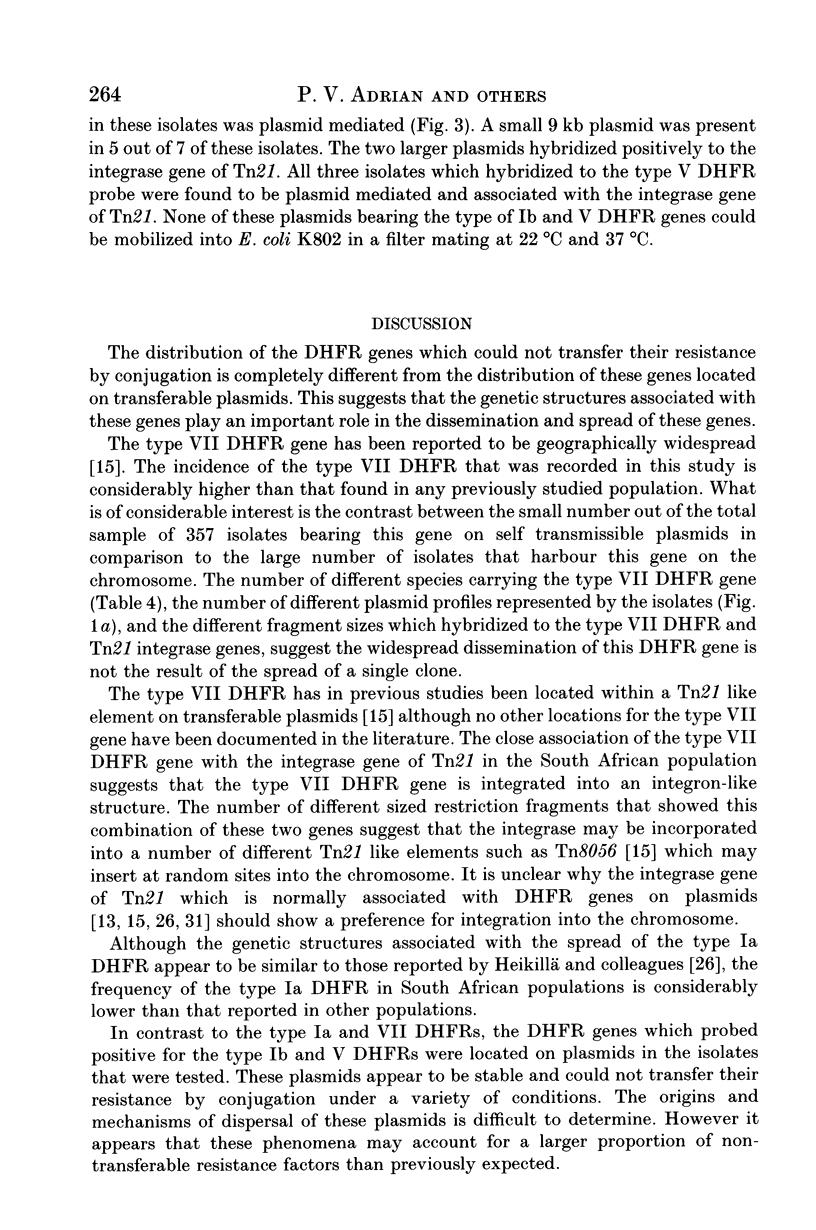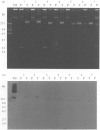Abstract
In a recent survey of trimethoprim resistance, 357 Gram-negative aerobic organisms were isolated from healthy volunteers from rural and urban populations in South Africa. Trimethoprim resistance did not transfer to an Escherichia coli J62-2 recipient strain by conjugation in a liquid mating in 161 (45.1%) of the isolates. These isolates which did not transfer their resistance were probed with intragenic oligonucleotide probes for the types Ia, Ib, IIIa, V, VI, VII, VIII, IX, X and XII dihydrofolate reductase genes. Contrary to all previous data, the most prevalent dihydrofolate reductase gene in this group of non-transferable isolates which hybridized, was the type VII (38%) followed by the type Ia (25%), Ib (12%), V (1.7%) and VIII (1.2%). None of the strains hybridized to the types IIIa, VI, XI, X and the XII dihydrofolate reductase probes. Southern blots of plasmid and chromosomal DNA from selective isolates revealed that the type VII dihydrofolate reductase genes were located on the chromosome and were associated with the integrase gene of Tn21. However, the type Ib and V dihydrofolate reductase genes were all found on plasmids which could not be mobilized. The type Ia dihydrofolate reductase genes were found on both non-transferable plasmids and on the chromosome. The nature of the genetic structures associated with a dihydrofolate reductase gene strongly affects the means of spread of the gene in a population.
Full text
PDF












Images in this article
Selected References
These references are in PubMed. This may not be the complete list of references from this article.
- Adrian P. V., Klugman K. P., Amyes S. G. Prevalence of trimethoprim resistant dihydrofolate reductase genes identified with oligonucleotide probes in plasmids from isolates of commensal faecal flora. J Antimicrob Chemother. 1995 Apr;35(4):497–508. doi: 10.1093/jac/35.4.497. [DOI] [PubMed] [Google Scholar]
- Adrian P. V., Koornhof H. J., Wylie B. A. Trimethoprim resistance in South African isolates of aerobic gram-negative faecal flora. Eur J Clin Microbiol Infect Dis. 1993 Dec;12(12):916–921. doi: 10.1007/BF01992165. [DOI] [PubMed] [Google Scholar]
- Amyes S. G., Smith J. T. R-factor trimethoprim resistance mechanism: an insusceptible target site. Biochem Biophys Res Commun. 1974 May 20;58(2):412–418. doi: 10.1016/0006-291x(74)90380-5. [DOI] [PubMed] [Google Scholar]
- Barg N. L., Hutson F. S., Wheeler L. A., Thomson C. J., Amyes S. G., Wharton M., Schaffner W. Novel dihydrofolate reductases isolated from epidemic strains of trimethoprim/sulfamethoxazole-resistant Shigella sonnei. J Infect Dis. 1990 Aug;162(2):466–473. doi: 10.1093/infdis/162.2.466. [DOI] [PubMed] [Google Scholar]
- Barg N. L., Register S., Thomson C., Amyes S. Sequence identity with type VIII and association with IS176 of type IIIc dihydrofolate reductase from Shigella sonnei. Antimicrob Agents Chemother. 1995 Jan;39(1):112–116. doi: 10.1128/aac.39.1.112. [DOI] [PMC free article] [PubMed] [Google Scholar]
- Barth P. T., Datta N., Hedges R. W., Grinter N. J. Transposition of a deoxyribonucleic acid sequence encoding trimethoprim and streptomycin resistances from R483 to other replicons. J Bacteriol. 1976 Mar;125(3):800–810. doi: 10.1128/jb.125.3.800-810.1976. [DOI] [PMC free article] [PubMed] [Google Scholar]
- Brumfitt W., Faiers M. C., Reeves D. S., Datta N. Antibiotic-resistant Escherichia coli causing urinary-tract infection in general practice: relation to faecal flora. Lancet. 1971 Feb 13;1(7694):315–317. doi: 10.1016/s0140-6736(71)91043-9. [DOI] [PubMed] [Google Scholar]
- Burchall J. J., Hitchings G. H. Inhibitor binding analysis of dihydrofolate reductases from various species. Mol Pharmacol. 1965 Sep;1(2):126–136. [PubMed] [Google Scholar]
- Chang L. L., Chang S. F., Chow T. Y., Wu W. J., Chang J. C. The distribution of the DHFR genes in trimethoprim-resistant urinary tract isolates from Taiwan. Epidemiol Infect. 1992 Dec;109(3):453–462. doi: 10.1017/s0950268800050445. [DOI] [PMC free article] [PubMed] [Google Scholar]
- DAVIS B. D., MINGIOLI E. S. Mutants of Escherichia coli requiring methionine or vitamin B12. J Bacteriol. 1950 Jul;60(1):17–28. doi: 10.1128/jb.60.1.17-28.1950. [DOI] [PMC free article] [PubMed] [Google Scholar]
- Flensburg J., Steen R. Nucleotide sequence analysis of the trimethoprim resistant dihydrofolate reductase encoded by R plasmid R751. Nucleic Acids Res. 1986 Jul 25;14(14):5933–5933. doi: 10.1093/nar/14.14.5933. [DOI] [PMC free article] [PubMed] [Google Scholar]
- Fling M. E., Kope J., Richards C. Characterization of plasmid pAZ1 and the type III dihydrofolate reductase gene. Plasmid. 1988 Jan;19(1):30–38. doi: 10.1016/0147-619x(88)90060-1. [DOI] [PubMed] [Google Scholar]
- Fling M. E., Richards C. The nucleotide sequence of the trimethoprim-resistant dihydrofolate reductase gene harbored by Tn7. Nucleic Acids Res. 1983 Aug 11;11(15):5147–5158. doi: 10.1093/nar/11.15.5147. [DOI] [PMC free article] [PubMed] [Google Scholar]
- Hall R. M., Stokes H. W. Integrons: novel DNA elements which capture genes by site-specific recombination. Genetica. 1993;90(2-3):115–132. doi: 10.1007/BF01435034. [DOI] [PubMed] [Google Scholar]
- Heikkilä E., Skurnik M., Sundström L., Huovinen P. A novel dihydrofolate reductase cassette inserted in an integron borne on a Tn21-like element. Antimicrob Agents Chemother. 1993 Jun;37(6):1297–1304. doi: 10.1128/aac.37.6.1297. [DOI] [PMC free article] [PubMed] [Google Scholar]
- Heikkilä E., Sundström L., Skurnik M., Huovinen P. Analysis of genetic localization of the type I trimethoprim resistance gene from Escherichia coli isolated in Finland. Antimicrob Agents Chemother. 1991 Aug;35(8):1562–1569. doi: 10.1128/aac.35.8.1562. [DOI] [PMC free article] [PubMed] [Google Scholar]
- Jansson C., Franklin A., Sköld O. Spread of a newly found trimethoprim resistance gene, dhfrIX, among porcine isolates and human pathogens. Antimicrob Agents Chemother. 1992 Dec;36(12):2704–2708. doi: 10.1128/aac.36.12.2704. [DOI] [PMC free article] [PubMed] [Google Scholar]
- Levy S. B., Marshall B., Schluederberg S., Rowse D., Davis J. High frequency of antimicrobial resistance in human fecal flora. Antimicrob Agents Chemother. 1988 Dec;32(12):1801–1806. doi: 10.1128/aac.32.12.1801. [DOI] [PMC free article] [PubMed] [Google Scholar]
- Levy S. B. Microbial resistance to antibiotics. An evolving and persistent problem. Lancet. 1982 Jul 10;2(8289):83–88. doi: 10.1016/s0140-6736(82)91701-9. [DOI] [PubMed] [Google Scholar]
- Lichtenstein C., Brenner S. Unique insertion site of Tn7 in the E. coli chromosome. Nature. 1982 Jun 17;297(5867):601–603. doi: 10.1038/297601a0. [DOI] [PubMed] [Google Scholar]
- Parsons Y., Hall R. M., Stokes H. W. A new trimethoprim resistance gene, dhfrX, in the In7 integron of plasmid pDGO100. Antimicrob Agents Chemother. 1991 Nov;35(11):2436–2439. doi: 10.1128/aac.35.11.2436. [DOI] [PMC free article] [PubMed] [Google Scholar]
- Shanahan P. M., Wylie B. A., Adrian P. V., Koornhof H. J., Thomson C. J., Amyes S. G. The prevalence of antimicrobial resistance in human faecal flora in South Africa. Epidemiol Infect. 1993 Oct;111(2):221–228. doi: 10.1017/s0950268800056922. [DOI] [PMC free article] [PubMed] [Google Scholar]
- Singh K. V., Reves R. R., Pickering L. K., Murray B. E. Identification by DNA sequence analysis of a new plasmid-encoded trimethoprim resistance gene in fecal Escherichia coli isolates from children in day-care centers. Antimicrob Agents Chemother. 1992 Aug;36(8):1720–1726. doi: 10.1128/aac.36.8.1720. [DOI] [PMC free article] [PubMed] [Google Scholar]
- Smith S. L., Stone D., Novak P., Baccanari D. P., Burchall J. J. R plasmid dihydrofolate reductase with subunit structure. J Biol Chem. 1979 Jul 25;254(14):6222–6225. [PubMed] [Google Scholar]
- Stone D., Smith S. L. The amino acid sequence of the trimethoprim-resistant dihydrofolate reductase specified in Escherichia coli by R-plasmid R67. J Biol Chem. 1979 Nov 10;254(21):10857–10861. [PubMed] [Google Scholar]
- Sundström L., Rådström P., Swedberg G., Sköld O. Site-specific recombination promotes linkage between trimethoprim- and sulfonamide resistance genes. Sequence characterization of dhfrV and sulI and a recombination active locus of Tn21. Mol Gen Genet. 1988 Aug;213(2-3):191–201. doi: 10.1007/BF00339581. [DOI] [PubMed] [Google Scholar]
- Sundström L., Swedberg G., Sköld O. Characterization of transposon Tn5086, carrying the site-specifically inserted gene dhfrVII mediating trimethoprim resistance. J Bacteriol. 1993 Mar;175(6):1796–1805. doi: 10.1128/jb.175.6.1796-1805.1993. [DOI] [PMC free article] [PubMed] [Google Scholar]
- Swift G., McCarthy B. J., Heffron F. DNA sequence of a plasmid-encoded dihydrofolate reductase. Mol Gen Genet. 1981;181(4):441–447. doi: 10.1007/BF00428733. [DOI] [PubMed] [Google Scholar]
- Tait S., Amyes S. G. Trimethoprim resistant dihydrofolate reductases in normal faecal flora isolated in India. Epidemiol Infect. 1994 Oct;113(2):247–258. doi: 10.1017/s0950268800051670. [DOI] [PMC free article] [PubMed] [Google Scholar]
- Thomson C. J., Barg N., Amyes S. G. N-terminal amino acid sequence of the novel type IIIb trimethoprim-resistant plasmid-encoded dihydrofolate reductase from Shigella sonnei. J Gen Microbiol. 1990 Apr;136(4):673–677. doi: 10.1099/00221287-136-4-673. [DOI] [PubMed] [Google Scholar]
- Thomson C. J., Young H. K., Amyes S. G. N-terminal amino-acid sequence and subunit structure of the type IV trimethoprim-resistant plasmid-encoded dihydrofolate reductase. J Med Microbiol. 1990 Jul;32(3):153–158. doi: 10.1099/00222615-32-3-153. [DOI] [PubMed] [Google Scholar]
- Towner K. J., Brennan A., Zhang Y., Holtham C. A., Brough J. L., Carter G. I. Genetic structures associated with spread of the type Ia trimethoprim-resistant dihydrofolate reductase gene amongst Escherichia coli strains isolated in the Nottingham area of the United Kingdom. J Antimicrob Chemother. 1994 Jan;33(1):25–32. doi: 10.1093/jac/33.1.25. [DOI] [PubMed] [Google Scholar]
- Tsakris A., Johnson A. P., Legakis N. J., Tzouvelekis L. S. Prevalence of the type I and type II DHFR genes in trimethoprim-resistant urinary isolates of Escherichia coli from Greece. J Antimicrob Chemother. 1993 May;31(5):665–671. doi: 10.1093/jac/31.5.665. [DOI] [PubMed] [Google Scholar]
- Wood W. B. Host specificity of DNA produced by Escherichia coli: bacterial mutations affecting the restriction and modification of DNA. J Mol Biol. 1966 Mar;16(1):118–133. doi: 10.1016/s0022-2836(66)80267-x. [DOI] [PubMed] [Google Scholar]
- Wylie B. A., Amyes S. G., Young H. K., Koornhof H. J. Identification of a novel plasmid-encoded dihydrofolate reductase mediating high-level resistance to trimethoprim. J Antimicrob Chemother. 1988 Oct;22(4):429–435. doi: 10.1093/jac/22.4.429. [DOI] [PubMed] [Google Scholar]
- Wylie B. A., Koornhof H. J. Nucleotide sequence of dihydrofolate reductase type VI. J Med Microbiol. 1991 Oct;35(4):214–218. doi: 10.1099/00222615-35-4-214. [DOI] [PubMed] [Google Scholar]
- Wylie B. A., Koornhof H. J. Trimethoprim resistance in gram-negative bacteria isolated in South Africa. J Antimicrob Chemother. 1989 Dec;24(6):973–982. doi: 10.1093/jac/24.6.973. [DOI] [PubMed] [Google Scholar]
- Young H. K., Amyes S. G. A new mechanism of plasmid trimethoprim resistance. Characterization of an inducible dihydrofolate reductase. J Biol Chem. 1986 Feb 25;261(6):2503–2505. [PubMed] [Google Scholar]
- Young H. K., Amyes S. G. Characterisation of a new transposon-mediated trimethoprim-resistant dihydrofolate reductase. Biochem Pharmacol. 1985 Dec 15;34(24):4334–4337. doi: 10.1016/0006-2952(85)90296-5. [DOI] [PubMed] [Google Scholar]
- Young H. K., Jesudason M. V., Koshi G., Amyes S. G. Trimethoprim resistance amongst urinary pathogens in south India. J Antimicrob Chemother. 1986 May;17(5):615–621. doi: 10.1093/jac/17.5.615. [DOI] [PubMed] [Google Scholar]
- Young H. K., Qumsieh M. J., McIntosh M. L. Nucleotide sequence and genetic analysis of the type Ib trimethoprim-resistant, Tn4132-encoded dihydrofolate reductase. J Antimicrob Chemother. 1994 Nov;34(5):715–725. doi: 10.1093/jac/34.5.715. [DOI] [PubMed] [Google Scholar]





